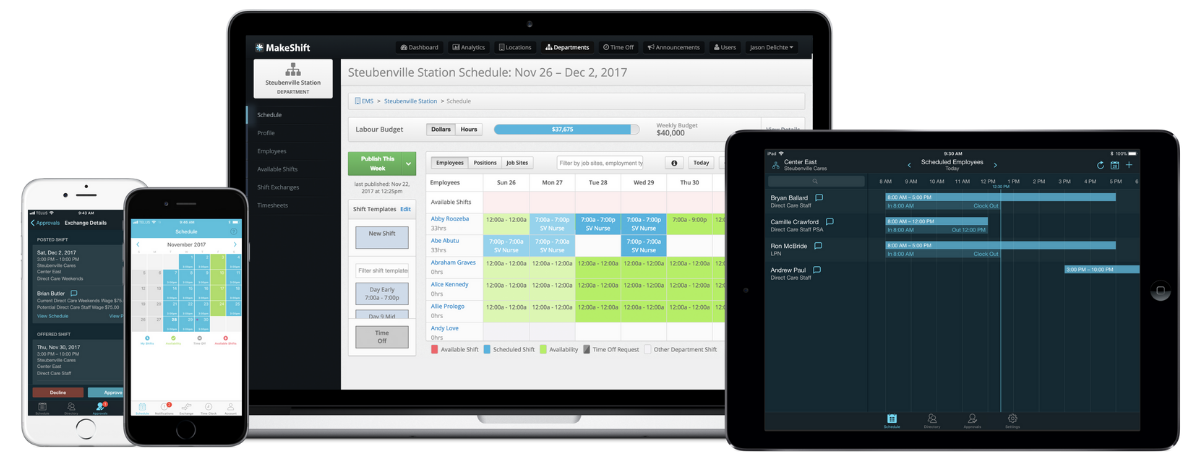Labor optimization is more than a business buzzphrase. It’s using your resources wisely, efficiently, and productively.
Optimizing your workforce means taking into account all the typical shift work scheduling challenges:
- Fluctuating demand
- Over/understaffing
- Employee burnout & fatigue
- Legal compliance
We know the idea of compiling and analyzing this data can feel overwhelming. It doesn’t have to.
You can automate much of your workforce optimization to factor in employee well-being, shift requirements, and labor budgets without breaking a sweat.
Today, we have 5 steps to help you optimize your labor force without shuffling through piles of paper or pulling out your hair.
- Step 1: No Goals, No Glory: Find Your “Whys” of Labor Optimization
- Step 2: Crack the Code on Workforce Requirements
- Step 3: Design Stellar Shift Schedules
- Step 4: Implement Staff Scheduling Software
- Step 5: Get Your Staff On Board
- FAQ
- MakeShift: Made for Optimizing Labor
- Labor Optimization Doesn’t Have to be Daunting
Step 1: No Goals, No Glory: Find Your “Whys” of Labor Optimization
“If you don’t know where you are going, you will probably end up somewhere else.” — Laurence J. Peter.
The point of labor optimization is to work smarter, not harder. So, first things first. Set your goals of what you want to accomplish by optimizing your workforce.
Your goals list may be longer than ours, but these will kickstart your brainstorming with goals and ideas on how to attain those goals.
Cut idle time & align workforce with workload
Idle time drains your bottom line and your staff’s energy. Excessive idle time at work can result in bored, disengaged employees who suffer from depression and high levels of stress and anxiety.
Aligning your workforce with your workload creates a more efficient, harmonious workplace that will cut labor costs, increase employee retention, and boost employee well-being.
What you can do:
- Analyze peak hours — Use data from past performance to identify peak and off-peak hours. Adjust staffing levels accordingly to ensure you’re not understaffed during busy or slow periods.
- Implement cross-training — Train employees in multiple roles to ensure flexibility in scheduling and coverage. Cross-training also encourages employees to reach their full potential.
Balance worker expertise with job demands
When employees get to do a job where they excel, their productivity, engagement, and confidence soar. Customer satisfaction improves when employees are passionate about serving them.
What you can do:
- Skill mapping — Create a comprehensive map of employee skills and match these with job requirements. This helps assign the right person to the right job, enhancing efficiency and job satisfaction.
- Schedule based on competency — Consider the complexity of tasks and the experience required when shift planning. Ensure that each shift has a balanced mix of novice and experienced workers to maintain productivity and provide mentoring opportunities.
Stay compliant
Staying on top of compliance requirements is much easier when actively optimizing your labor force. Workforce optimization eliminates excessive last-minute overtime that may land you in the compliance hot seat.
What you can do:
- Know your industry’s regulations — Stay up-to-date with changes in labor laws relevant to your industry and region. This includes understanding overtime rules, mandatory rest periods, and other compliance requirements (e.g., HIPPA, union agreements…etc.).
- Use compliance tools — For example, scheduling software with compliance features can alert managers when a proposed schedule might violate labor laws to help avoid potential legal issues and penalties.
Improve employee job satisfaction
Job satisfaction can have a huge impact on your business’ success. High employee job satisfaction boosts motivation, retention, engagement, and customer satisfaction.

Gallup estimates that an empowered and motivated employee boosts profit by 21%, sales by 20%, and has 70% fewer safety incidents.
What you can do:
- Ask for feedback — Regularly gather employee input regarding their shift preferences and any issues with the current scheduling system. This can be achieved through surveys, suggestion boxes, or regular meetings.
- Implement flexible scheduling — Where possible, offer flexible scheduling options like self-scheduling or shift swaps that allow employees some control over their working hours. This can lead to increased job satisfaction and reduced turnover.
Step 2: Crack the Code on Workforce Requirements
To optimize your labor force at the highest level, your next step is to examine your team's needs. How can you set your employees up for success?
Use these tips to identify your workforce requirements proactively.
Nail down staffing needs based on operational demands
How many staff members do you need per shift to keep your operation running smoothly? Here’s how to find the right answer:
- Conduct a demand analysis — Review historical data on sales, customer footfall, and production levels to forecast needed staffing for different times and days.
- Strategic scheduling — Adapt your workforce size strategically in response to real-time demand using predictive analytics tools.
Let forecasting tools do the heavy lifting
You don’t need to shuffle through past data and try to compile this info on your own. Let AI do the sifting and compiling.
- Implement advanced analytics software — Tools that integrate AI to forecast future demand based on trends, seasonal variations, and other external factors make workforce planning a breeze.
- Train managers to understand AI data — Ensure your managers understand how to read and act on data provided by forecasting tools to make informed scheduling decisions.
Plan for Flexibility
Flexibility is an essential component of labor optimization. No matter how well you plan shifts, your team is still made of humans with lives. Plan for the unexpected with these ideas:
- Create a buffer pool — Maintain a pool of part-time or on-call workers who can be brought in during unexpected demand spikes or to cover last-minute absences.
- Establish clear policies — Develop and communicate policies for shift changes and absences to ensure quick and fair resolutions that maintain operational efficiency.
Step 3: Design Stellar Shift Schedules
Every industry has specific shift schedules that best meet their unique business and employee needs. Follow these steps to ensure your shift schedules jive with your operation.
Implement scheduling models that serve your employees
First, evaluate shift types and weigh the pros and cons of each type (e.g., fixed vs. rotating) in the context of your operation and employee preferences. Let’s look at a couple of examples:
Healthcare Industry (Hospitals)
Shift Type: 12-Hour Shifts — Nurses and other clinical staff typically work 12-hour shifts. These shifts usually run from 7 AM to 7 PM for day shifts & 7 PM to 7 AM for night shifts.
Manufacturing Industry
Shift Type: Rotating Shifts — Workers alternate between morning, afternoon, and night shifts in a predefined pattern. Each shift might be 8 hours long, typically 7 AM to 3 PM, 3 PM to 11 PM, and 11 PM to 7 AM.
Schedule for peak efficiency — Design shifts that align employee availability with expected business peaks, ensuring optimal staffing levels throughout the operation.
Commit to fair and predictable scheduling
Prioritize fairness and predictability in your employee scheduling to let your staff know their well-being, mental health, and personal lives are important. Try these ideas to accomplish this:
- Rotate undesirable shifts — Rotate less desirable shifts fairly among employees to maintain morale and reduce burnout.
- Roll out schedules in advance — Provide schedules well in advance to give employees sufficient time to plan their personal lives around their work commitments.
Handle Special Cases with Compassion
Sometimes, you’ll need employees to work unexpected overtime to fill a shift gap.
Other times, your carefully planned schedule must be adapted based on employee availability. Put care and consideration for your staff above all else with these tips:
- Manage overtime strategically — Develop a strategy for overtime that considers cost implications and employee well-being. Use overtime as a tool to handle unexpected demands rather than a regular practice.
- Support shift swapping — Facilitate a system where employees can swap shifts under management supervision to accommodate personal needs without disrupting operational requirements.
Hint: Our system recommendation is step #4.
Step 4: Implement Staff Scheduling Software
When done right, labor optimization can cut the fat while boosting productivity and employee well-being. But you don’t have to shoulder all the tasks that come with proper workforce optimization.
You can let staff scheduling software do most of the work for you. Ready to transition to scheduling software? Follow these tips for successful adoption:
Choose the right software
There are a lot of options out there. Weigh out features vs. needs during your research process.
Match software features like mobile access, integration with payroll systems, and real-time updates with your organization’s specific needs.
Use this checklist to compare solutions:

✓ Industry specific — Software developed with your industry in mind will most likely best suit your needs.
✓ Ease of use — Your software should be user-friendly and not overly complicated to learn.
✓ Internal communication — Internal communication allows your team to trade shifts and see which shifts are available easily.
✓ Reminders & notifications — Push notifications to your team will revolutionize your staff communication method.
✓ Mobile app — Everyone keeps their phone in their pocket. A mobile app means you and your nursing home staff can manage schedules on the fly.
✓ AI-powered support — Streamline scheduling and workforce optimization by allowing AI to shift through data and make data-backed recommendations.
Streamline implementation
Do your best to make your scheduling software implementation uncomplicated. The keys to this are having lots of available support and taking it one step at a time.
Keep these ideas in mind when you are prepping for implementation:
- Provide comprehensive training — Ensure all users are thoroughly trained to use the new system to its fullest capability. The more training you offer, the better the odds of a higher adoption rate.
- Phase implementation — Roll out the software in phases to allow adjustment time and minimize disruption to your existing processes.
Step 5: Get Your Staff On Board
Congrats, you’ve made it to the last step. 👏 You’ve done your research, made your selection, and provided staff training support.
Now it’s time to get your team fully on board with labor optimization — use these tips to promote staff involvement.
Involve employees in scheduling
Trust us, your employees want more say in their work schedules, so this won’t be a hard sale. You can upgrade scheduling by making it more people-centered using these tips:
- Encourage participation — Use scheduling software features that allow employees to input their availability and shift preferences.
- Transparent decision-making — To build trust and acceptance among your workforce, keep the scheduling process transparent.
Enhance communication channels
Communication is a cornerstone of optimization workflows and company culture.
According to a McKinsey report, improved communication and collaboration through social technologies could raise productivity by 20-25%.

Elevate your team communication with these 2 tips:
- Use tech to communicate — It’s handy to choose scheduling software with integrated messaging apps to facilitate easy and immediate communication between staff and managers. This improves communication because everyone is communicating within a single channel.
- Regular updates & feedback — Keep lines of communication open for employees to express concerns and receive updates on any changes to their schedules or company policies related to work hours.
FAQ
What is scheduling optimization?
Scheduling optimization is figuring out the best way to use resources (like people, time, and equipment) so that everything runs smoothly and efficiently. It’s ensuring everyone does the right thing at the right time to get the most out of every minute.
What are the benefits of a workforce scheduler?
Workforce scheduling software can significantly improve an organization's operations. It saves time by automating the scheduling process and reducing the manual effort involved. This automation also minimizes errors, leading to more accurate schedules.
This leads to employee satisfaction improving because the scheduler can balance workloads and consider individual preferences, leading to happier and more engaged staff. Additionally, scheduling software enhances flexibility, making handling last-minute changes and adjustments easier without disrupting the workflow.
How can scheduling help in improving the performance and efficiency of an organization?
Effective scheduling can significantly enhance an organization’s performance and efficiency. By ensuring that everyone works when they’re most needed, productivity is maximized. Good scheduling also reduces downtime, prevents idle times, and ensures tasks are completed on schedule.
How to Make Labor Optimization More Automatic
Create AI-optimized schedules, track time, manage budgets, and more. MakeShift helps you get the right people in the right place and time.
MakeShift is an intelligent workforce management platform that simplifies labor optimization by doing the heavy lifting for you.
Optimize your staffing with features designed to make scheduling effortless.
- Automated scheduling — Automate scheduling based on rules, availability, and workload requirements. Create templates for recurring shifts and common patterns.

- Adjust on the go — Our mobile app and responsive web interface allow managers and employees to conveniently access schedules, submit availability, and make or approve time-off requests on their smartphones or tablets.

- Manage labor budgets — Set daily, weekly, or custom labor budgets to align with your financial targets. Adjust your budget in hours or dollars to manage employee workload and control costs effectively.

- Stay compliant automatically — Easily monitor, manage, and enforce fatigue and other union rules to maintain compliance with labor laws, promote employee well-being, and minimize the risk of legal consequences or workplace safety issues.

- AI-powered platform — MakeShift's ShiftMate AI optimizes shift assignments based on employee skills, availability, and past performance. This intelligent tool predicts staffing needs and suggests optimal scheduling to enhance productivity and reduce labor costs.

Labor Optimization Doesn’t Have to be Daunting
Today’s businesses need to tighten their belts wherever they can. Optimizing your workforce is smart for today and forward-thinking for tomorrow.
Figuring out how to use your resources wisely doesn’t have to become your full-time job.
Let MakeShift show you how simple workforce planning can be. Schedule a FREE demo today.








